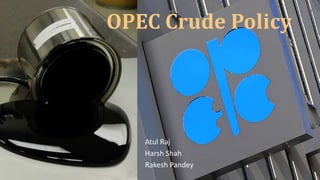OPEC and it's policy
- 1. Atul Raj Harsh Shah Rakesh Pandey OPEC Crude Policy
- 2. âĒ Price Drop Effect âĒ Importers of OPEC oil âĒ Pipelines Route âĒ Summary âĒ Introduction to OPEC âĒ Objectives of OPEC âĒ Membersâ Share in Production âĒ Past Oil Embargo Overview 2
- 3. âĒ Formed in 1960 to unify policy of Petroleum exporting countries. âĒ 11 members produce about 40% of worldâs crude oil, and hence influences the market greatly. âĒ It has more than 2/3rd of worldâs crude oil resource. Introduction to OPEC 3
- 4. âĒ The main objective of OPEC is to ensure the âstabilization of oil prices in international marketsâ âĒ To secure a steady income to oil producing nations. âĒ To fulfil the demands of Oil in non-producing countries. Policy Of OPEC 4
- 5. Algeria, 1130, 4% Angola, 1777, 6% Ecuador, 553, 2% Iran, 2754, 9% Iraq, 3353, 11% Kuwait, 2777, 9% Libya, 343, 1% Nigeria, 1940, 7%Qatar, 680, 2% Saudi Arabia, 9683, 32% UAE, 2841, 9% Venezuela, 2321, 8% Share of Members Fig 1: Production Data of OPEC in Janâ15 ( â000 bbl/day) 5
- 6. âĒ (n.) Prohibition of the trade of petroleum from one country to another. âĒ Past embargoes due to war in Syria and Israel. âĒ Gulf War also lead to embargo. Oil Embargo in Past Fig 2: Price Change of Crude 6
- 7. âĒ Due to increase in US oil production, Crude oil prices have fallen âĒ OPEC members have decided not to cut their production even when the price is low. âĒ A butterfly effect causes the whole equilibrium to shift. Price Drop Effect Fig 3: Fall of Crude oil price in 14-15 7
- 8. Importer of OPEC Crude Fig 4: Export by Saudi Arabia Fig 5: Export by Iraq 8
- 9. Transport: The framework of Crude supply âĒ Strait of Hormuz & Suez Canal is a critical point for oil supply. âĒ Pipelines have total length of 1,942,669 km (2010) âĒ Saudi Arabia uses Redundancy by maintaining extra pipeline structure for security purpose. Fig 6: Common Transport Route 9
- 10. âĒ Crude Oil is the major source of Energy all around the globe and new prospects are opening up with improving technology. âĒ OPEC has been largely dictating pricing of crude up to now, but we are expecting this to stop soon. âĒ Falling oil price could delay investment in alternate âgreenerâ forms of energy Summary 10
- 11. âĒ http://www.opec.org/opec_web/en/data_graphs/330.htm âĒ http://wtrg.com/opecshare.html âĒ http://marketshareanalysis.blogspot.in/2010/08/market-share- within-opec.html âĒ OPEC Annual Statistical Bulletin 2014 âĒ OPEC Monthly Oil Market Report â February 2015 Bibliography 11











